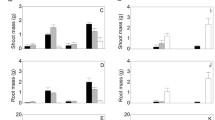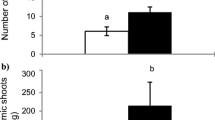Abstract
The effect of artificial shoot clipping on the vegetative growth and sexual reproduction of the evergreen bearberry, Arctostaphylos uva-ursi, and the deciduous bog bilberry, Vaccinium uliginosum, was studied in the vicinity of a copper-nickel smelter in SW Finland. According to the research hypothesis, heavy metal induced shoot death breaks the apical dominance in the clones growing in a polluted environment. This causes activation of dormant axillary and adventitious buds and an increase in branching on the older parts of the stem. Regrowth after shoot death was studied by clipping off all the current-year shoots from experimental branches in autumn (1994) and spring (1995). Within-clone and between-clone control branches were used to test the data.
Both species displayed a considerable ability to activate dormant meristems after the damage. Regrowth of the current shoots during the next growing season (1995) was about 80% compared to the within-clone control in both species after autumn clipping. Shoot clipping in early summer was more detrimental for both species, and the regrowth of A. uva-ursi was less than that of V. uliginosum. Differences in the storage reserves and source-sink mechanisms of carbon allocation between evergreen and deciduous species probably explain their distinct response. When the removed biomass was added to the living biomass of the branches, there was overcompensation in the total dry weight of A. uva-ursi after autumn clipping, and the weight was almost 90% of the control after spring clipping. The total dry weight of V. uliginosum also equalled that of the control when the removed biomass was added. No berries developed on either species in the year following the autumn treatment, because clipping removed all the flower buds. Spring clipping had no effect on the sexual reproduction of A. uva-ursi, but decreased the berry production of V. uliginosum. The degree of compensatory growth of both species was only slightly affected by the distance from the smelter. It is suggested that dormant bud activation, rapid regrowth and plastic branching contribute to the resistance mechanism to heavy metals.
Similar content being viewed by others
References
Aarssen, L. W. 1995.Hypothesis for the evolution of apical dominance in plants: implications for the interpretation of overcompensation. Oikos 74: 149-156.
Archer, S. & Tieszen, L. L. 1980. Growth and physiological responses of tundra plants to defoliation. Arct. Alp. Res. 12: 531-552.
Baker, A. J. M. 1981. Accumulators and excluders-strategies in the response of plants to heavy metals. J. Plant Nutr. 3: 643-654.
Baker, A. J. M. 1987. Metal tolerance. New Phytol. 106: 93-111.
Balsberg, A.-M. 1982. Plant biomass, primary production and litter disappearance in a Filipendula ulmaria meadow ecosystem, and the effects of cadmium. Oikos: 72-90.
Balsberg-Påhlsson, A.-M. 1989. Toxicity of heavy metals (Zn, Cu, Cd, Pb) to vascular plants. Water, Air, Soil Pollut. 47: 287-319.
Belsky, A. J. 1986. Does herbivory benefit plants? A review of the evidence. Am. Nat. 127: 870-892.
Belsky, A. J., Carson, W. P., Jensen, C. L. & Fox, G. 1993. Overcompensation by plants: herbivore optimization or red herring? Evol. Ecol. 7: 109-121.
Bowles, J. M. 1983. Burl sprouting in Arctostaphylos uva-ursi as a response to trampling damage. Can. J. Bot. 61: 3543-3545.
Chapin, F. S. III 1980a. Nutrient allocation and responses to defoliation in tundra plants. Arct. Alp. Res. 12: 553-563.
Chapin, F. S. III 1980b. The mineral nutrition of wild plants. Ann. Rev. Ecol. Syst. 11: 233-260.
Chapin, F. S. III 1983. Nitrogen and phosphorus nutrition and nutrition cycling by evergreen and deciduous understorey shrubs in an Alaskan black spruce forest. Can. J. For. Res. 13: 773-781.
Chester, A. L. & McGraw, J. B. 1983. Effects of nitrogen addition on the growth of Vaccinium uliginosum and Vaccinium vitis-idaea. Can. J. Bot. 61: 2316-2322.
Chester, A. L. & Oechel, W. C. 1986. Effects of leaf nitrogen availability and leaf position on nitrogen allocation patterns in Vaccinium vitis-idaea and Vaccinium uliginosum. Oecol. (Berl.) 69: 121-125.
Dickinson, N. M., Turner, A. P. & Lepp, N. W. 1991. How do tree and other long-lived plants survive in polluted environments? Funct. Ecol. 5: 5-11.
Eriksson, O. & Fröborg, H. 1996. 'Windows of opportunity' for recruitment in long-lived clonal plants: experimental studies of seedling establishment in Vaccinium shrubs. Can. J. Bot. 74: 1369-1374.
Ernst, W. H. O. 1974. Schwermetallvegetation der Erde. Gustav Fischer Verlag, Stuttgart.
Fröborg, H. 1996. Pollination and seed production in five boreal species of Vaccinium and Andromeda (Ericaceae). Can. J. Bot. 74: 1363-1368.
Gimmingham, C. H. 1972. Ecology of heathlands. Chapman and Hall, London.
Helmisaari, H.-S., Derome, J., Fritze, H., Nieminen, T., Palmgren, K., Salemaa, M. & Vanha-Majamaa, I. 1995. Copper in Scots pine forests around a heavy-metal smelter in south-western Finland. Water, Air Soil Pollut. 85: 1727-1732.
Hjälten, J., Danell, K. & Ericson, L. 1993. Effects of simulated herbivory and intraspecific competition on the compensatory ability of birches. Ecology 74: 1136-1142.
Honkanen, T. & Haukioja, E. 1995. Why does a branch suffer more after branch-wide than after tree-wide defoliation. Oikos 71: 441-450.
Jacquemart, A.-L. 1996. Vaccinium uliginosum, L. Biological flora of the British Isles. J. Ecol. 84: 771-785.
Johnson, D. A. & Tieszen, L. L. 1976. Aboveground biomass allocation, leaf growth, and photosynthesis patterns in tundra plant forms in Arctic Alaska. Oecol. (Berl.) 24: 159-173.
Karlsson, P. S. 1985. Patterns of carbon allocation above ground in a deciduous (Vaccinium uliginosum) and an evergreen (Vaccinium vitis-idaea) dwarf shrub. Physiol. Plant. 63: 1-7.
Karlsson, P. S. 1987. Micro-site performance of evergreen and deciduous dwarf shrubs in a subarctic heath in relation to nitrogen status. Holarctic Ecol. 10: 114-119.
Karlsson, P. S. 1989.In situ photosynthetic performance of four coexisting dwarf shrubs in relation to light in a subarctic woodland. Funct. Ecol. 3: 481-488.
Laaksovirta, K. & Silvola, J. 1975. Effect of air pollution by copper, sulphuric acid and fertilizer factories on plants at Harjavalta, W. Finland. Ann. Bot. Fenn. 12: 81-88.
Levitt, J. 1980. Responses of plants to environmental stresses. Academic Press, New York.
Marshall, C. 1996. Sectoriality and physiological organisation in herbaceous plants: an overview. Vegetatio 127: 9-16.
Marquis, R. J. 1996. Plant architecture, sectoriality and plant tolerance to herbivores. Vegetatio 127: 85-97.
Maschinsky, J. & Whitham, T. G. 1989. The continuum of plant responses to herbivory: the influence of plant association, nutrient availabilty, and timing. Am. Nat. 134: 1-19.
Packer, J. G. & Denford, K. E. 1974. A contribution to the taxonomy of Arctostaphylos uva-ursi. Can. J. Bot. 52: 743-753.
Remphrey, W. R., & Steeves, T. A. 1984a.Shoot ontogeny in Arctostaphylos uva-ursi (bearberry): the annual cycle of apical activity. Can. J. Bot. 62: 1925-1932.
Remphrey, W. R., & Steeves, T. A. 1984b. Shoot ontogeny in Arctostaphylos uva-ursi (bearberry): origin and early development of lateral vegetative and floral buds. Can. J. Bot. 62: 1933-1939.
Remphrey, W. R., Steeves, T. A. & Neal, B. R. 1983. The morphology and growth of Arctostaphylos uva-ursi (bearberry): an architectural analysis. Can. J. Bot. 61: 2430-2450.
Salemaa, M. & Vanha-Majamaa, I. 1993. Forest vegetation change along a pollution gradient in SW Finland. Proc. First Finnish Conference of Environmental Sciences. Kuopio Univ. Pub. C. Nat. Env. Sci. 14: 101-104.
SAS Institute, Inc. 1994. SAS/STAT User's Guide Version 6. 4th Edition. SAS Institute Inc., Cary, North Carolina, USA.
Shevtsova, A., Ojala, A., Neuvonen, S., Vieno, M. & Haukioja, E. 1995. Growth and reproduction of dwarf shrubs in a subarctic plant community: annual variation and above-ground interactions with neighbours. J. Ecol. 83: 263-275.
Stewart, W. S. & Bannister, P. 1973. Seasonal changes in carbohydrate content of three Vaccinium spp with particular reference to V. uliginosum L. and its distribution in the British Isles. Flora Bd. 162: 134-155.
Sutinen, M.-L., Raitio, H., Nivala, V., Ollikainen, R. & Ritari, A. 1996. Effects of emissions from copper-nickel smelters on the frost hardiness of Pinus sylvestris needles in the subarctic region. New Phytol. 132(3): 503-512.
Tiffney, W. N., Benson, D. R. & Eveleigh, D. E. 1978. Does Arctostaphylos uva-ursi (Bearberry) have nitrogen-fixing nodules? Amer. J. Bot. 65: 625-628.
Tolvanen, A. & Laine, K. 1997. Effect of reproduction and artificial herbivory on vegetative growth and resource levels in deciduous and evergreen dwarf shrubs. Can. J. Bot. 75: 656-666.
Tolvanen, A., Laine, K., Pakonen, T. & Havas, P. 1995. Recovery of evergreen clonal dwarf shrub Vaccinium vitis-idaea after simulated microtine herbivory in a boreal forest. Vegetatio 116: 1-5.
Tolvanen, A., Laine, K., Pakonen, T., Saari, E. & Havas, P. 1993. Effect of habitat and time of clipping on the recovery of the bilberry (Vaccinium myrtillus). Ann. Bot. Fenn. 30: 15-20.
Tuomi, J., Nilsson, P. & Åström, M. 1994. Plant compensatory responses: bud dormancy as an adaptation to herbivory. Ecology 75: 1429-1436.
Tutin, T. G., Heywood, V. H., Burges, N. A., Moore, D. M., Valentine, D. H., Walters, S. M. & Wegg, D. A. 1972. Flora Europaea. Vol. 3. Cambridge University Press, Cambridge.
Tyler, G., Balsberg Påhlsson, A.-M., Bengtson, G., Bååth, E. & Tranvik, L. 1989. Heavy metal ecology of terrestrial plants, micro organisms and invertebrates. Water, Air, and Soil Poll. 47: 189-215.
Verkleij, J. A. C. & Schat, H. 1989. Mechanisms of metal tolerance in higher plants. Pp. 179-193. In: Shaw, J. A. (ed.), Heavy metal tolerance in plants: evolutionary aspects. CRC Press, Florida.
Väisänen, S. 1986. Effects of air pollution by metal, chemical and fertilizer plants on forest vegetation at Kokkola, WFinland. Ann. Bot. Fenn. 23: 305-315.
Watson, M. A. & Casper, B. B. 1984. Morphogenetic constraints on patterns of carbon distribution in plants. Ann. Rev. Ecol. Syst. 15: 233-258.
Author information
Authors and Affiliations
Rights and permissions
About this article
Cite this article
Salemaa, M., Vanha-Majamaa, I. & Gardner, P. Compensatory growth of two clonal dwarf shrubs, Arctostaphylos uva-ursi and Vaccinium uliginosum in a heavy metal polluted environment. Plant Ecology 141, 79–91 (1999). https://doi.org/10.1023/A:1009847728799
Issue Date:
DOI: https://doi.org/10.1023/A:1009847728799




